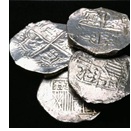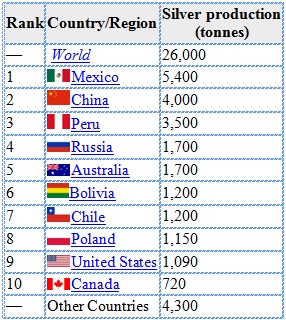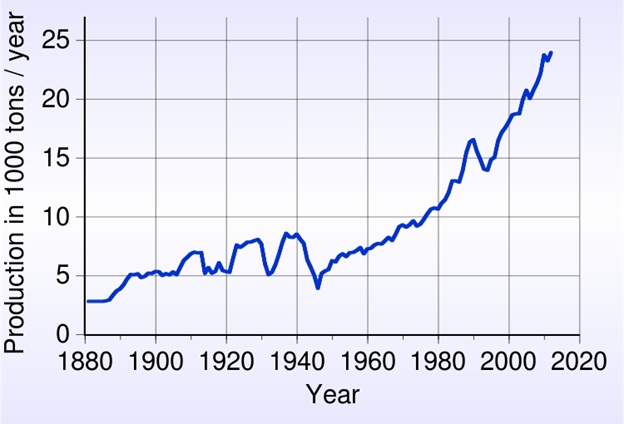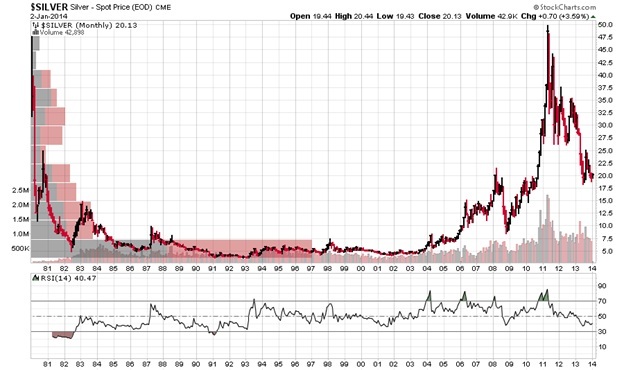History Of Silver
 The history of silver covers several millenniums…and is replete with astounding facts. Indeed and fact the white metal has had an enormous impact upon mankind. Consider just a few outstanding influences silver has had on civilization, on global culture and industrial growth.
The history of silver covers several millenniums…and is replete with astounding facts. Indeed and fact the white metal has had an enormous impact upon mankind. Consider just a few outstanding influences silver has had on civilization, on global culture and industrial growth.
Silver’s Impact On World History
-30 pieces of silver and Jesus betrayal
-Used universally as money for many millenniums
-Peru’s Inca Silver financed Spain’s conquest of Europe in the 15th Century
-Most used raw material for development of Photography & Electrical Industries
-Universal Medical usage
-Electronic and Solar Technology
-Major export of a few silver producing nations
30 pieces of silver and Jesus betrayal
According to the New Testament, one of the twelve original apostles of Jesus Christ was Judas Iscariot. Judas is notoriously known for his kiss and betrayal of Jesus to the hands of the chief Sanhedrin priests in exchange for a payment of thirty silver coins. Subsequently, Jesus was crucified and died on the cross. Thus was born the Christian movement, which today accounts for 2.3 billion Christians in the world that represents about 33% of the world population.
Used universally as money for many millenniums
The shekel was an ancient unit used in Mesopotamia around 3000 BC to define both a specific weight of barley and equivalent amounts of materials such as silver, bronze and copper. The use of a single unit to define both mass and currency was a similar concept to the British pound, which was originally defined as a one pound mass of silver. Today, most major countries in the world circulate silver coins. Moreover, already three US states have recently passed laws recognizing silver as legal tender: Arizona, Oklahoma and Utah…and movements are afoot in Kansas, Texas, and South Carolina to follow suit. And in the event this silver acceptance continues, the Fed in Washington will finally wake up and make it national.
Peru’s Inca Silver financed Spain’s conquest of Europe in the 15th Century
The Spanish Empire (Spanish: Imperio español), commonly referred to at the time as the Spanish Monarchy, comprised territories and colonies administered by the Spanish Crown in Europe, the Americas, Africa, Asia and Oceania. It originated during the Age of Exploration after the Discovery of America as one of the first global empires. Under the Spanish Habsburgs, Spain reached the peak of its political and economic power, becoming the foremost global power of the time. Spain's territorial reach beyond Europe included half of South, Central America, the Greater Antilles, Florida, territories in much of today's Southwestern United States and a number of Pacific Ocean archipelagos including the Philippines. The bulk of Spain's Empire was held for over three centuries, starting with the voyages by Christopher Columbus in 1492, and lasting until the Spanish American wars of independence of the early 19th century. Spain financed the majority of these conquests via silver stolen from the Inca Empire of Peru. A detailed account of this may be seen at Silver Price Charts & Other Factors Say Now Is Time To Buy (Part 1) and Silver Price Charts And Other Factors Say Now Is Time To Buy (Part 2) .
Most used raw material for development of Photography & Electrical Industries
In the period between roughly 1900 and 1970, industrial demand for silver increased over 4 times from 100 million to 400 million ounces. The industrial revolution in silver was due largely to the urbanization and technological revolutions taking place in twentieth century life. Whether we are talking about indoor plumbing, electricity, cars, or aerospace technology, silver proved to be an indispensable metal. One of the largest industrial uses for silver came from photography, invented by Frenchmen Nicephore Niecpe in 1822, and made more popular by Daguerre in the 1840s (Source: Ryan Jordan).
Medical Usage
The medical uses of silver include its incorporation into wound dressings, creams, and as an antibiotic coating on medical devices. There is tentative evidence that silver coatings on urinary catheters and endotracheal breathing tubes may reduce the incidence of catheter-related urinary tract infections and ventilator-associated pneumonia, respectively. The silver ion (Ag+) is bioactive and in sufficient concentration readily kills bacteria in vitro. Silver exhibits low toxicity in the human body, and minimal risk is expected due to clinical exposure by inhalation, ingestion, dermal application. Silver and silver nanoparticles are used as an antimicrobial in a variety of industrial, healthcare and domestic applications. (Source: Wikipedia.org)
Electronic and Solar Technology
Almost all electronics are configured with silver. From turning out the lights to turning on your television, if it has an on/off button, it’s likely that silver is playing an important role, behind the scenes.
Silver’s superb electrical conductivity makes it a natural choice for everything from printed circuit boards to switches and TV screens. CDs, DVDs and plasma display panels are also fabricated using silver.
One of the growing industrial uses for silver is photovoltaic cells in SOLAR PANELS as the world seeks alternative forms of energy, metal consultancies said. There has been an enormous jump in such demand in recent years, and analysts say millions more ounces of silver may be consumed for this over the next decade.
“Solar panels will probably be one of the leading industrial uses,” said Jessica Cross, CEO of VM Group.
Use of the long-established photovoltaic technology, referred to as PV, “really took” off in the last half decade, helped by government subsidies, said Philip Newman, research director for GFMS.
“The growth in demand did not primarily come about because of technological developments,” he said. “It came about because of changing attitudes of governments and government policy.”
Major export of a few silver producing nations (Source: Wikipedia.org)

Silver production and exports are the main sources of foreign income for Mexico, Peru and Bolivia. Not so with China and the other countries as they enjoy export product diversification. To be sure the economies of Mexico, Peru and Bolivia tend to rise and fall with the international price of the white metal.
The Silver Production chart below clearly demonstrates the white metal enjoys enormous global demand, having grown from 2,500 tons per year (1880) to nearly 24,000 tons/year. Moreover, the recent rate of yearly growth appears to be exponential.
Source: Wikipedia.org
Silver Price Forecast
Without fear of exaggeration, one might say silver has a sterling future (pardon the pun). Consequently, the white metal will someday retest its all-time high price of $49/oz reached in 1980 and again in 2011. And in the event that the Euro Union dismembers with corresponding currency devaluations, the value of silver may well go into orbit...well above its all-time record high. Moreover, monetary analysts are forecasting $2,500 to $3,000 gold in a few years. And since silver has historically been more volatile (upside and downside) than gold, we might see silver soaring to more than $100/oz.
Read More:
Silver Price Forecast Based On China’s Viral Demand
Silver Price Forecast Per The Rule Of 7
Silver Price Charts And Other Factors Say Now Is Time To Buy (Part 3)
Silver Price Charts And Other Factors Say Now Is Time To Buy (Part 2)
Silver Price Charts & Other Factors Say Now Is Time To Buy (Part 1)
www.silver-phoenix500.com/search/node/HISTORY%20OF%20SILVER
Vital Silver Statistics
World’s Largest Silver Consumers (By percent)
World’s Largest Silver Consumers (By Ounces)



















